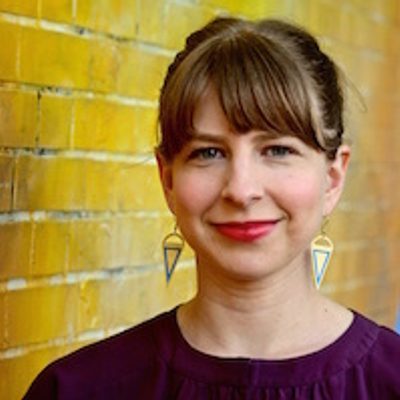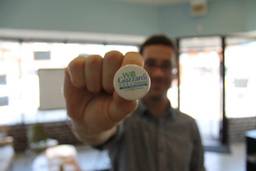6 Lessons for the U.S. from Spain’s Democratic Revolution
How Spain’s 15M movement went from occupying city squares to city halls—without compromising its independence
Erica Sagrans
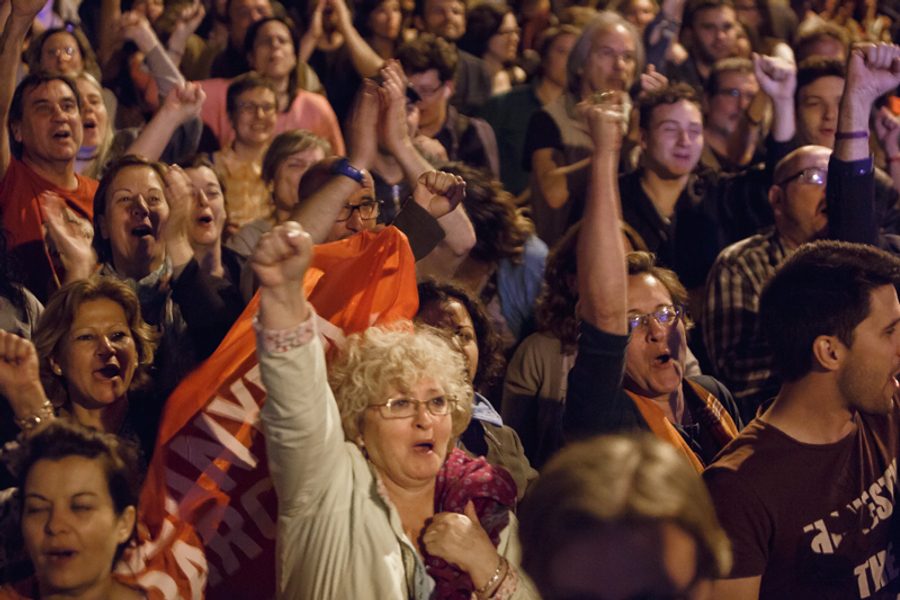
When tens of thousands of people occupied city squares across Spain in the spring of 2011 as part of the 15M movement, their demand was simple: ¡Democracy Real Ya!—“a real democracy,” instead of the corrupt, top-down system that had failed to address the country’s skyrocketing foreclosures and unemployment.
On Sunday, May 24, Spain took a huge step towards the kind of radical democracy that the occupiers envisioned. In municipal elections, Barcelona, Madrid and several other cities elected new mayors or governments from progressive platforms that have emerged out of the 15M movement.
In Barcelona, the new mayor is Ada Colau, co-founder of the anti-foreclosure group called the PAH (Plataforma de Afectados por la Hipoteca/Platform of People Affected by Mortgages), which has moved families that need housing into empty, bank-owned buildings. Colau was elected with the backing of Barcelona En Comú, a citizen platform that includes groups that came directly out of the 15M movement, as well as Podemos, the insurgent left party that has risen to national prominence. And in Madrid, Ahora Madrid’s “popular unity” candidate Manuela Carmena, a well-respected former judge and labor lawyer, is poised to become mayor once a coalition government is formed.
I traveled to Barcelona and Madrid last week with a group of U.S. activists to witness the historic elections firsthand and learn from Spain’s independent social movements. What I saw was a whole new way of doing politics — a model that has the potential to shake up U.S. assumptions about how to run and fund successful movements and campaigns.
Here are six key lessons that U.S. activists and organizers can learn from the wins in Spain — ideas to help us build a stronger and more inclusive progressive movement both within electoral politics and outside them.
1) Movements should keep pushing for radical and participatory democracy by engaging directly with electoral politics — while also maintaining their independence from established parties.
In advance of Spain’s municipal elections, movement activists worked with existing political parties to create new “convergence” platforms of “popular unity” specifically for May 24. Barcelona En Comú and Ahora Madrid were not traditional parties, but rather a mix of groups working together — including Podemos and more local efforts that had come out of 15M and the activism that preceded it — while maintaining their own structures and decision-making process.
Though complicated and challenging, this structure allowed movement groups to maintain their autonomy without being engulfed by the larger party, Podemos. (While many Spanish activists are encouraged by the rise of Podemos, they are also quick to remind you that the party did not come from the 15M movement).
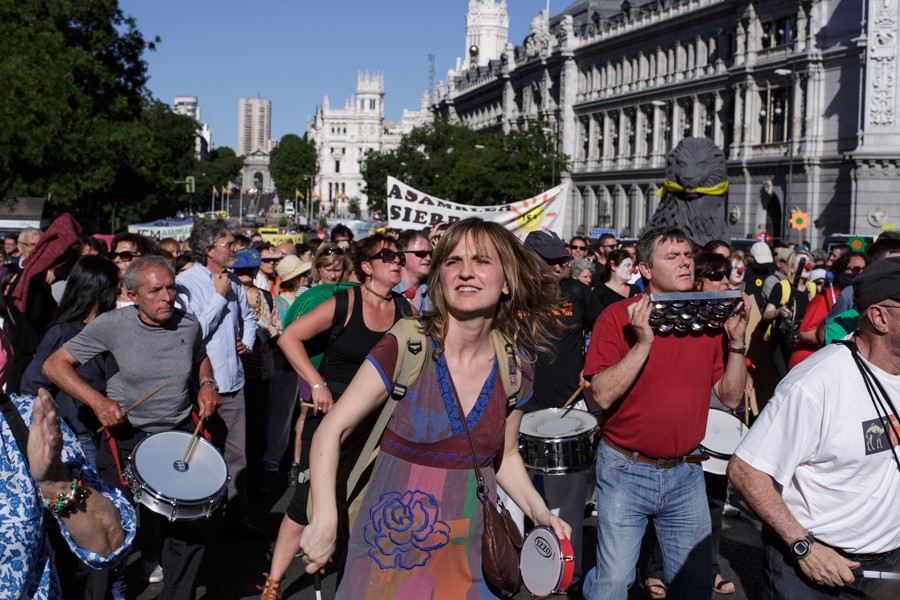
The 15M anniversary march in Madrid on May 16. (Robert Pluma)
2. Take steps before the vote to make sure the officials you elect will be accountable to the movement.
Barcelona En Comú candidates signed a code of political ethics called “Governing by obeying,” in which they agreed to a reduced salary and making their schedules and income sources public. They also pledged to open up local government, democratize government institutions and promote increased, direct citizen participation as a way to strengthen social movements and make sure they don’t lose energy post-victory. Marina Lopez, an activist with Barcelona En Comú, says that now that they have taken power in city government, “we have to continue to exist as a political organization that is close to the citizens and neighborhoods… this is our strength.”
When Ada Colau and 10 new City Council members took to the stage at the Barcelona En Comú victory party on Sunday, what struck me was that they looked like, well, activists, and not professional politicians. Colau wore jeans, and the others looked like they’d been out organizing all day, no suits or heels in sight.
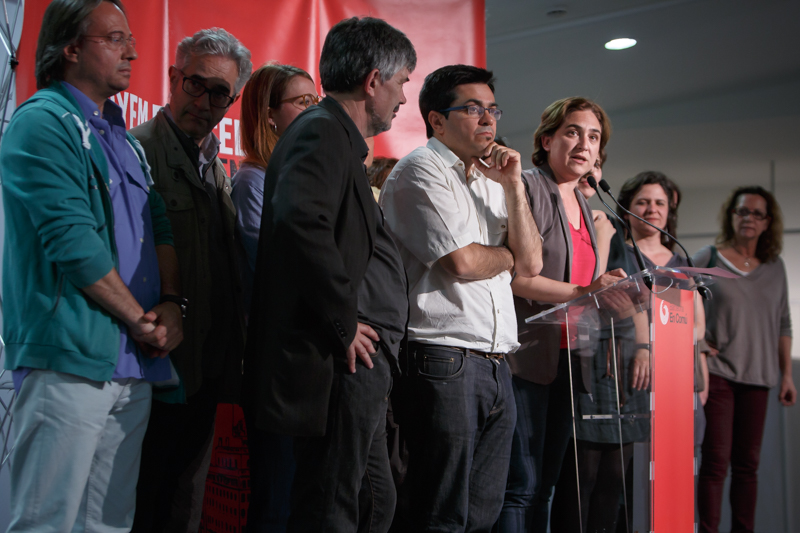
Ada Colau and the new City Council members onstage. (Robert Pluma)
What these local efforts in Spain have done so far is rightly say that activists should run for office — but that once elected, they can remain activists pushing for a more open and participatory democracy.
Ernesto Garcia Lopez, an organizer with Ahora Madrid, says that in addition to working inside the governing coalition, he and others are now focused on showing that the outside movement continues.
“We’re going to create a huge wave of collective assemblies in each neighborhood in order to create pressure to power local government by the movement and citizens directly,” he says. “If we only think about management of new government, then our idea of radical democracy is not possible.”
3) Create physical spaces for local organizing outside of existing institutions
An important part of progressives’ recent electoral success can be traced to a strong network of locally organized “social centers” across Spain. These are spaces where community members can interact and share ideas, whether that means organizing a demonstration, taking Zumba classes or checking out library book. Many subsist on small membership fees or income from a bar or café. Many served as gathering places for organizing 15M after the movement decided to end its large-scale occupations and focus on building neighborhood-level power.
In the United States, similar spaces are much harder to find — partly because rents are so much higher in major cities. But some American activists are taking inspiration from Spain’s social centers and starting their own. Lucas Shapiro, who organized the activist delegation to Spain I took part in, is creating the Mayday Space in Brooklyn, with the aim of fostering a “interconnected movement ecosystem” where different projects and people can overlap, share ideas and shift the political terrain. Shapiro, who spent time at the social center Ateneu Candela in Terrassa, Spain, says that these centers “create a cultural current within a city that reinforces the autonomous spirit of resistance.”
4) Question the professionalization of movement organizing
Two words we never heard in Spain were “staff” and “volunteer.” Almost every organizer we met — whether for a group, movement or campaign — was doing the work in their free time, without an institutional affiliation or paycheck.
Luis Moreno-Caballud, an activist and professor at the University of Pennsylvania from Spain who took part in our delegation, points out that in the United States, the paid versus unpaid distinction can create a separation between “professional” activists and volunteers or people affected by an issue. In Spain, there are not paid staff who tell volunteers what to do — the volunteers are the leaders, with much more decision-making power.
I’ve found, too, that the large institutions and amounts of money involved in U.S. political organizing can sometimes make it hard to figure out if we’re doing the work we want to do, or the work that we can get funded. And the focus on funding can create an atmosphere of competition for grants and resources.
While it’s tempting to romanticize the purity of getting money out of politics — break free of capitalism! — Spain’s model has its own drawbacks. Organizers in the United States can get paid for doing movement work we care about, and without funding, for many of us that would not be possible. And with an unemployment rate above 40 percent for young people in Spain, I suspect that many Spanish activists would not object to getting paid for doing work that generally aligns with their values.
But Moreno-Caballud suggests exploring alternatives to institutional or big-donor funding. “It can be powerful when you see you can do things without money,” he says. He suggests that U.S. activists can look at strategies of mutual aid and building a social economy — where organizers exchange goods and services — or an alternative economy, through activist-run bookstores or bars.
A volunteer movement means, too, that more time can be spent organizing instead of writing grants or fundraising. As Lucía Lois Méndez de Vigo from the Patio Maravillas social center in Madrid told us, “We have one meeting a year to talk about money.” As someone who’s spent countless hours writing fundraising emails and calling donors to ask for money, that sounds like a pretty great idea.
From what I saw, the lack of professionalization in Spain’s social justice movement also seemed to create a culture that is less ego-driven. For the most part, organizing jobs don’t exist, and there isn’t a career ladder — so people are generally doing things with their spare time because it’s what they want to be doing and believe in, and they aren’t assessed based on title or organization, but reputation and work they’ve done.
5) Inject some creativity into our electoral campaigns
Elections in the U.S. are fast becoming more a science than an art, with a focus on exactly how many times a voter needs to be contacted, in what ways and with which words. Yet for all our data-driven sophistication, as I saw the campaigning happening in Spain I couldn’t help but feel like our U.S. campaigns are, by comparison, a little rote and lifeless.
A week before the election in Madrid, I joined Ahora Madrid for a “walking tour” of the gentrifying neighborhood of Malasaña. But it was more like a parade, led by bikes flying Ahora Madrid flags and speakers blasting campaign songs. Every few blocks, we paused, and a speaker explained through the bullhorn what was happening in the neighborhood. People gave out flyers and buttons, talked to passersby and put up stickers. Up at the front, someone rolled a 7-foot inflatable blue plastic ball emblazoned with the campaign’s demand, Agua Publica, through the narrow cobblestone streets.
We shouldn’t abandon what’s been proven to be effective to get voters to the polls. But what Podemos and these local platforms have managed to do is use imagination and humor to completely transform the sense of what’s politically possible in Spain. As one Podemos banner reads, “When was the last time you voted with hope?”
6) Put feminism and women’s leadership front and center
Sunday’s local election results broke new ground for women in Spain. Ada Colau is the first female mayor of Barcelona — in a region of Spain, Catalonia, where previously only 14.2 percent of cities were run by women. Six of the 11 people elected to municipal offices on the Barcelona En Comú ticket are women, and one, Laura Perez, is a well-known feminist leader.
That’s no accident: The campaigns had an explicitly feminist agenda that includes fighting the “feminization” of poverty and expanding our gendered ideas of leadership. Several of the organizers I spoke with talked about getting away from the traditional idea of a male leader who speaks loudly and confidently and tells everyone what to do, and moving more towards a style of cooperation, discussion and listening. In her election night speech, Ada Colau focused on thanking the “common” people — the people who did the work of caring for the kids and making the food. Feminists, she said, have shown that there’s another way to do politics.

The Barcelona En Comú victory party on May 24. (Robert Pluma)
Many activists in the United States feel that we have to choose one of two options: Suck it up and compromise to help a Democratic Party we aren’t always ideologically aligned with, or sit on the sidelines of electoral politics. But Spain shows a third way is possible — a social movement can take part in politics while maintaining its activist identity and independence.
Of course, the context is different in the United States. Before Occupy Wall Street, Spain’s 15M movement took hold in a deeper way than Occupy did in the United States. It started in 2011 with the 15M movement of Indignados—the Outraged — protesting the way Spain had been controlled by a two-party system for over 30 years; outraged at politicians’ failure to respond to the severe economic crisis, rampant corruption and skyrocketing foreclosures and unemployment. And it led to a fundamental change in Spain’s political landscape, with an explosion of new activist groups, organizing spaces and political parties.
While Spain’s parliamentary system means that creating new parties is easier than in the U.S., local elections in particular often present a more open field. City Council elections in places like Chicago and Los Angeles are non-partisan, and could be a space for similar movement-driven coalitions like we saw in Spain. In building them, we should look to the 15M movement as a model for creating the kind of radical participatory democracy we thought we could only imagine.
